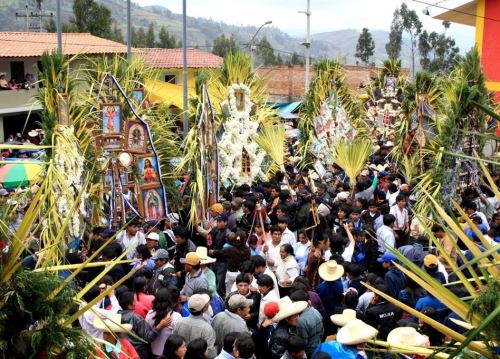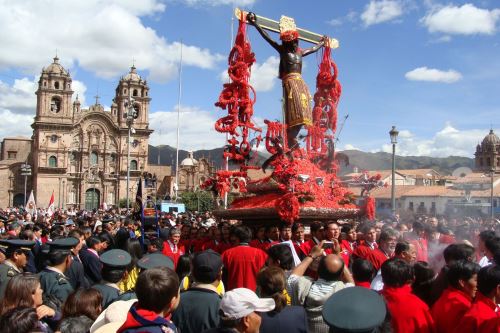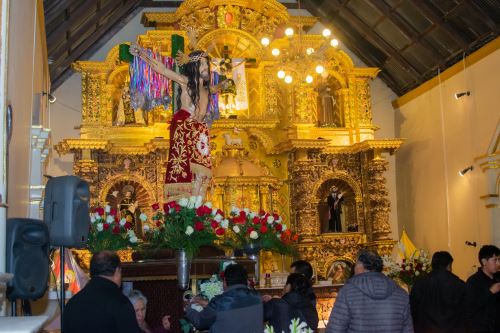Holy Week is celebrated throughout Peru. In some regions, this religious festivity is the most important of the year.
Find out which ones.
People can experience the fervor and devotion for Holy Week in various places in Peru.
Dozens of tourists flock to experience the joy and tradition, but some of them are the favorite ones for the public, for example, the recreations of the life of Jesus in the streets; processions that challenge physical endurance and faith; and unique masses to celebrate the patron saints.
Learn how this very important festivity is celebrated in different destinations in our country:
Ayacucho

The religious celebration in Ayacucho is the second-largest, only after the one held in Seville (Spain).
Ayacucho starts Holy Week three days before Palm Sunday, with the eve of the Friday of Sorrows.
On that day, the image of the Virgen Dolorosa (Sorrowful Virgin) and the Señor de la Agonia (Lord of the Agony) are carried in a night procession from the Magdalena church.
On the Saturday of the Passion, a significant quantity of yellow and green palms can be seen. On Sunday, from very early in the morning, the parishioners gather at the Cathedral Basilica for the blessing of flowers and palms, which are carried during the staging of Jesus and his triumphal entry into Jerusalem.
On Monday, they continue with the procession of the Señor del Huerto (Lord of the Garden); on Tuesday, with the Señor de la Sentencia (Lord of the Sentence).
The staging of the meeting of Jesus, his mother, and Mary Magdalene takes place on Wednesday.
The following day, the Last Supper and other religious activities take place with the participation of the Bishop of Ayacucho.
On Friday, the procession of the Santo Sepulcro (Holy Sepulcher) departs from the Santo Domingo Church.
Saturday of Glory allows for more tourist-related activities: A visit to the Ayacucho viewpoint to appreciate it in its maximum splendor is a good option.
The Resurrection Mass takes place in the Cathedral Basilica on Sunday. That same day during the first hours of the morning, the "Anda" parades through the Plaza de Armas (Main Square) to the beat of music and fireworks.
Cajamarca

The province of Contumaza is one of the most visited not only for its landscapes and food but also for the people's fervor.
Maundy Thursday and Good Friday are commemorated in the streets: they perform penance at midnight each day. And as part of the festivity, people walk to the nearest church to confess their sins.
In the district of Porcon, one of the main celebrations of the entire Peruvian north takes place.
The Festival of the Crosses of Porcon begins on Palm Sunday morning with the traditional "Señorca" (a donkey carries the image of Christ portraying his entry into Jerusalem).
The crosses -which measure more than two meters high and weigh between 70 and 80 kilos- are adorned with mirrors, pictures, and flowers, representing the souls of the devotees. Songs in Quechua and native dances follow the procession.
Cusco

Palm Sunday begins at 9 a.m. (local time) with the traditional blessing of the palms, procession, and Eucharistic celebration in the Cathedral Basilica.
The main day, however, is Monday because the Señor de los Temblores (Lord of the Earthquakes), which was established after the devastating earthquake of March 31, 1650, in the Imperial City, is carried in procession.
The image has been consecrated as the Sworn Patron Saint of Cusco.
On Good Friday, the main stage is the Plaza San Francisco, where the Stations of the Cross begin, and the route is to the Cross of the Pope in Saqsaywaman.
At the same time, the Hampi Rantikuy (fair of medicinal plants) takes place in the same Plaza: the crosses of thorns, placed on the doors of the homes of Cusco, stand out.
Moquegua

The celebration takes place in the district of Omate, declared a Cultural Heritage of the Nation in 2010.
The protagonist is the Lord of the Sorrows, who is depicted on a cross with four nails and carried through the main streets.
On Holy Thursday and Good Friday, parishioners build seven altars of up to 20 meters high to accompany him, followed by songs and fireworks.
Editor's note: Information provided by PromPeru via peru.info / Images provided by Andina News Agency and PromPeru.
(END) NDP/JMP/MVB